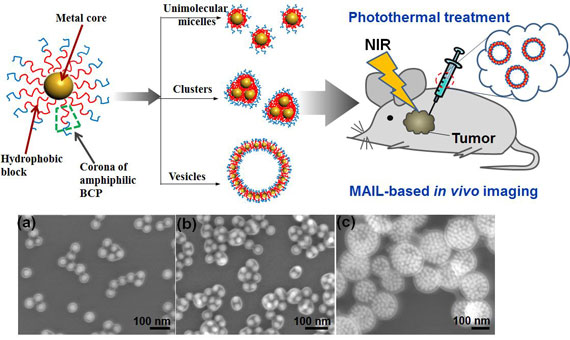| Posted: Jun 12, 2013 | |
How to design complex assemblies based on micelle-like nanostructures (w/video) |
|
| (Nanowerk Spotlight) One major challenge in contemporary science is to accomplish with synthetic building blocks what nature does so well, that is, creating complex and functional structures through multiple levels of assembly of biomolecules (i.e., proteins). Bottom-up engineering of nanostructures that assemble themselves from polymer molecules are bound to become useful tools in chemistry (see for instance: "Self assembled nanostructures for hostile environments"), energy (see: "Researchers produce new photoactive micelles with potential applications in photofunctional dyes and sensors"), and medicine (read more: "A pH-responsive nanoscale vaccine with tailored immune responses"). To that end, researchers are using block copolymer based micellar architectures to form hierarchical superstructures with defined shape and geometry. | |
| "In spite of tremendous achievement in the past decade, a model platform to describe the behavior of these nanoscale building blocks and how they organize to form higher ordered structures, is missing" Zhihong Nie, an Assistant Professor in the Department of Chemistry and Biochemistry at the University of Maryland, tells Nanowerk. "Ideally, such building blocks should illustrate the well-defined chemistry and architectures of block copolymer micelles." | |
| In new work, reported in a recent edition of JACS ("Self-Assembly of Amphiphilic Plasmonic Micelle-Like Nanoparticles in Selective Solvents"), Nie and his group demonstrate that nanoparticles tethered with block copolymers resemble micelles that can assemble into well-ordered higher level mesostructures. These assembly sub-units are not only much easier to be created – compared to micellar building blocks purely based on block copolymers – but also have precisely defined dimension, chemistry, shape, and composition. | |
| This work is a systematic study of how to design complex hierarchical structures based on micelle-like nanostructures. Potential applications for these assemblies are drug delivery, cancer imaging and treatment, and the design next generation of optoelectronic materials. | |
| A brief video shows the TEM image of a vesicle structure: | |
| "Our system serves as a simple model to elucidate the behavior both in terms of chemistry and spatial length scales of higher level of self-assembly in block copolymer based complex nanostructures," explains Jie He, a post-doc in Nie's group and first author of the paper. "Basically, what we did was to establish a simple but effective model system comprising of nanoparticle core and grafted block copolymers to understand the design rules that control this multiple level self-assembly, and to design functional assembled materials with controlled properties for various applications." | |
| The scientists used gold nanoparticles as scaffolds to bring multiple block copolymers together in a controlled manner, resulting in a micelle-like structure – but without multistep synthesis and self-assembly. | |
| "This presence of gold nanoparticles as the 'micelle' cores endows the localized surface plasmon resonance properties to such building blocks," says He. "The controlled assembly of these amphiphilic plasmonic micelle-like nanoparticles enables the modulation of the plasmon coupling between individual building blocks, thus the collective properties of assemblies." | |
| In another paper, published in the May 23, 2013 online edition of ACS Nano ("Photosensitizer-Loaded Gold Vesicles with Strong Plasmonic Coupling Effect for Imaging-Guided Photothermal/Photodynamic Therapy"), the team demonstrates an application of their plasmonic nanostructures as a theranostic platform for cancer imaging and treatment. | |
 |
|
| Top row: The schematic of gold nanoparticles based mesoscale structures that show micelle, cluster and vesicle-like morphologies and its potential application in photothermal treatment. Bottom row: Scanning electron microscopy images of gold nanoparticles tethered to block copolymers of different molecular weights and their corresponding morphology. (Reprinted with permission from American Chemical Society) | |
| Although it is a useful model to understand the hierarchical structures, the team points out that a more quantitative model is required to predict and design more complex nanostructures. | |
| "In our model, we interpreted that deformability of the micelle-like nanoparticles, play a crucial role but we cannot quantitatively predict the assemblies and correlate various factors to the final products of assembly yet," says Nie. | |
| He notes that there is still no effective means of controlling and predicting the multiple-level assembly behaviors of molecules and particles. | |
| "In future research, it will be critical to design effective model systems to quantitatively evaluate the kinetics and thermodynamics of assembly, and to assess the roles of various factors governing assembly." | |
 By
Michael
Berger
– Michael is author of three books by the Royal Society of Chemistry:
Nano-Society: Pushing the Boundaries of Technology,
Nanotechnology: The Future is Tiny, and
Nanoengineering: The Skills and Tools Making Technology Invisible
Copyright ©
Nanowerk LLC
By
Michael
Berger
– Michael is author of three books by the Royal Society of Chemistry:
Nano-Society: Pushing the Boundaries of Technology,
Nanotechnology: The Future is Tiny, and
Nanoengineering: The Skills and Tools Making Technology Invisible
Copyright ©
Nanowerk LLC
|
|
|
Become a Spotlight guest author! Join our large and growing group of guest contributors. Have you just published a scientific paper or have other exciting developments to share with the nanotechnology community? Here is how to publish on nanowerk.com. |
|
